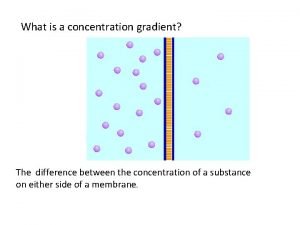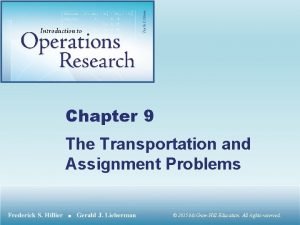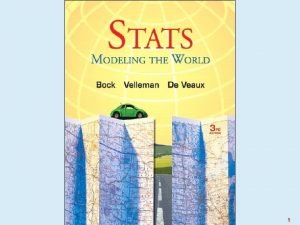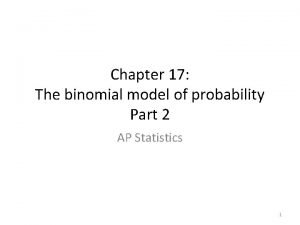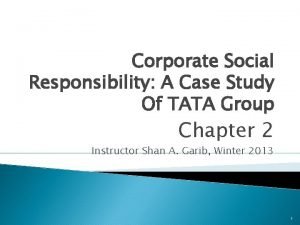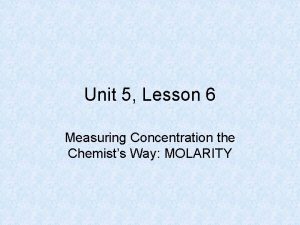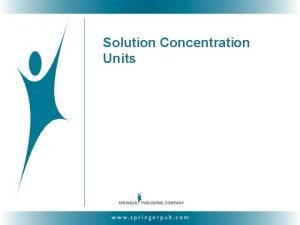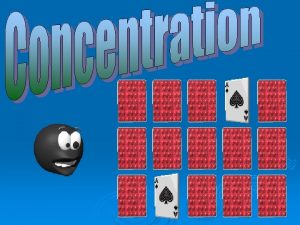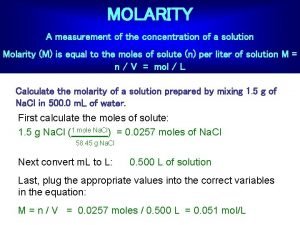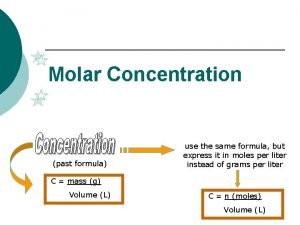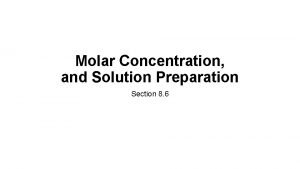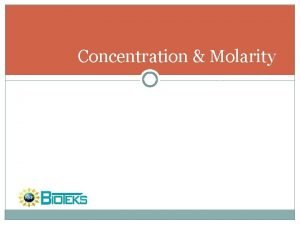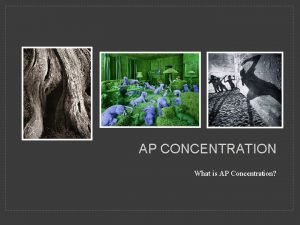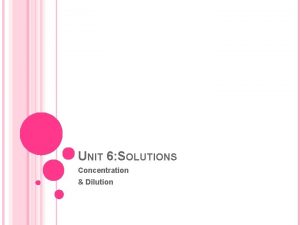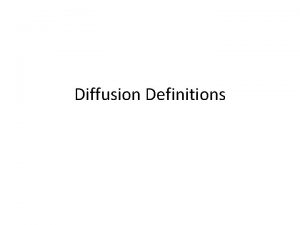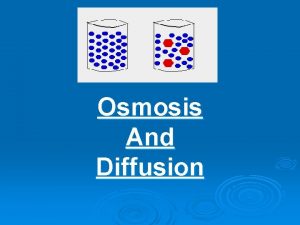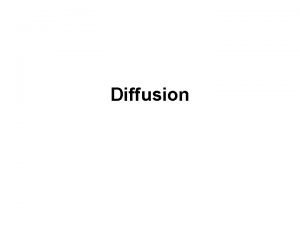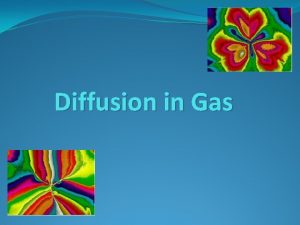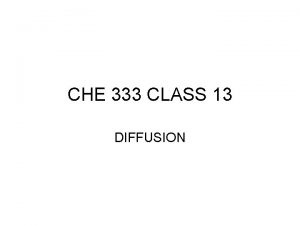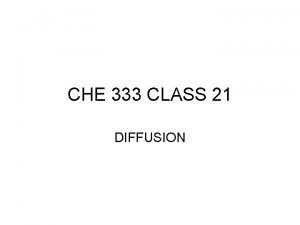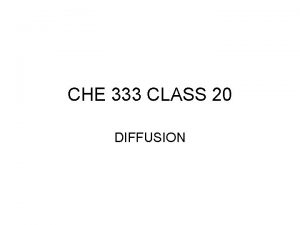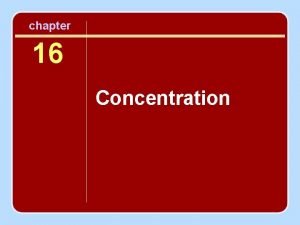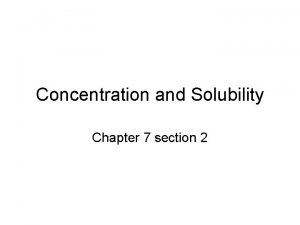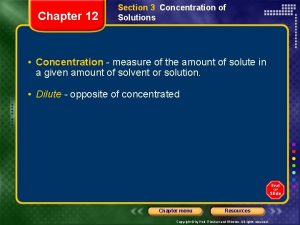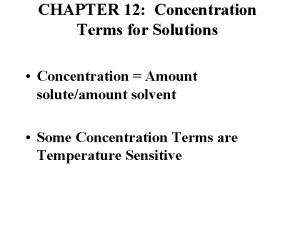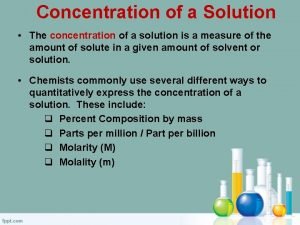CHAPTER 5 Concentration Models Diffusion Model Diffusion model

































- Slides: 33

CHAPTER 5 Concentration Models: Diffusion Model

Diffusion model • Using the Gaussian plume idea. • Consideration: – The point source is the chimney or smoke stack. – One need to measure concentration downwind form the point source

• The Gaussian Plume. Physical stack height = h The plume rise = h Effective stack height, H = h + h ir a d e t f eo na i m nta co m Plu Figure A

• The Gaussian Plume. Assumptions: • Wind blows in the x direction, with air d velocity, u and emission rate, Q, and te a n mi a t it is independent n co f o e of time, location m Plu or elevation. Figure A

• Through material balance around a cube of space near the center of the plume, and considering the dispersion due to turbulent mixing: z x y

Diffusion Model – Gaussian Plume • Gaussian puff, 3 D spreading • Applicable to an instantaneous shot-term release of pollutants from the chimney shown in previous figure, i. e. at x = y = 0 and z = H where • K = turbulent dispersion coefficient • x = the distance upwind or downwind from the center of the moving puff • t = time since release • t = time duration of release

Diffusion Model – Gaussian Plume • Gaussian plume, 2 D spreading • Applicable to steady-state release of plume. • Assume negligible net transfer of material in the x direction zamriab@petronas. com. my

• The above equation is generally used by making the following substitutions: Where: y = horizontal dispersion coefficient z = vertical dispersion coefficient zamriab@petronas. com. my

Diffusion Model – Gaussian Plume • Making the substitutions, we find: • Basic 2 D Gaussian Plume equation

Example 5: • A factory emits 20 g/s of SO 2 at height H. The wind speed is 3 m/s. At a distance of 1 km downwind, the values of σy and σz are 30 and 20 m, respectively. What are the SO 2 concentrations at the centerline of the plume, and at a point 60 meters to the side and 20 meters below the centerline? zamriab@petronas. com. my

Solution • At centreline, y = 0 and z = H (refer Fig. A). Thus, at centreline: • At the point away from the centreline, zamriab@petronas. com. my

Diffusion Model – Gaussian Plume • The basic Gaussian plume equation predicts a plume that is symmetrical with respect to y and with respect to z. • Different values of σy and σz mean that spreading in the vertical and horizontal directions is not equal. • To find the approximated values for σ y and σ z ,

Diffusion Model – Gaussian Plume Surface Wind Speed (at 10 m), m/s Day Night Incoming Solar radiation Thinly Clear or overcast or 3/8 cloud 4/8 cloud Strong Moderate Slight 0– 2 A A–B B – – 2– 3 A–B B C E F 3– 5 B B–C D D E 5– 6 C C–D D 6 C D D Note: The neutral class D should be assumed for overcast conditions during day or night

• Horizontal dispersion coefficient, y, as a function of downwind distance from the source for various stability categories

• Vertical dispersion coefficient, z, as a function of downwind distance from the source for various stability categories

Diffusion Model – Gaussian Plume Some modifications The effect of the ground • The ground damps out vertical dispersion and vertical spreading terminates at ground level. • Commonly assumed that any pollutants that would have carried below z = 0 if the ground were not there; are ‘reflected’ upward as if the ground is a mirror

Diffusion Model – Gaussian Plume Some modifications • Therefore: zamriab@petronas. com. my

Example 6: • If z = 10 m, repeat the calculation in Example 5 for the cases where H = 20 m and where H = 30 m.

Solution: • H = 20 m zamriab@petronas. com. my

Solution: • H = 30 m zamriab@petronas. com. my

Example 7 A large, poorly controlled copper smelter has a stack 150 m high and a plume rise of 75 m. It is currently emitting 1000 g/s SO 2. Estimate the ground level concentration of SO 2 from this source at a distance 5 km directly downwind when the wind speed is 3 m/s and the stability class is C.

Solution • • • Q = 1000 g/s u = 3 m/s y = 438 m – from Figure 1 z = 264 m – from Figure 2 y = h + h = 225 m zamriab@petronas. com. my

Diffusion Model – Gaussian Plume Ground level concentration, simplified • At ground level, z = 0. • Substituting into the previous equation: zamriab@petronas. com. my

Diffusion Model – Gaussian Plume Ground level concentration, simplified • At y = 0 and z = 0 correspond to the line on the ground directly under the centerline of the plume • Rearrange: zamriab@petronas. com. my

Diffusion Model – Gaussian Plume Ground level concentration, simplified • We can plot a graph of cu/Q vs. distance x. zamriab@petronas. com. my

Ground-level , directly under the plume centreline, as a function of downwind distance from the source an effective stack height, H, in meters, for stability Class C only

Example 8 A plant is emitting 750 g/s of particulates. The stack height is 100 m and the plume rise is 50 m. The wind speed is 7 m/s and the stability category is C. a) What is the maximum estimated ground-level concentration ? b) How far downwind it does occur?

Plume Rise • Figure below shows the plume rising a distance h, called the plume rise, above the top of the stack before leveling out.

Plume Rise • Plumes rise buoyantly because they are hotter than the surrounding air and also because they exit the stack with a vertical velocity that carries them upward.

Plume Rise • They stop rising because: (i) they mix with surrounding air (ii) they lose velocity (iii) they cool by mixing

Plume Rise • To estimate h, Holland’s formula is: where h Vs D u P Ts Ta = plume rise, m = stack exit velocity, m/s = stack diameter, m = wind speed, m/s = pressure, mbar = stack gas temperature, K = atmospheric temperature, K

Example • Estimate the plume rise for a 3 m diameter stack whose exit gas has a velocity of 20 m/s when the wind velocity is 2 m/s, the pressure is 1 atm, and the stack and surrounding temperatures are 100 o. C and 15 o. C, respectively. • Solution:

End of Lecture
 Concentration gradient vs concentration difference
Concentration gradient vs concentration difference Movement of high concentration to low concentration
Movement of high concentration to low concentration Swabt
Swabt Stimulus diffusion diagram
Stimulus diffusion diagram Difference between modals and semi modals
Difference between modals and semi modals Cultural convergence
Cultural convergence Chapter 9 transportation and assignment models solutions
Chapter 9 transportation and assignment models solutions Chapter 17 sampling distribution models
Chapter 17 sampling distribution models Ap stats chapter 17 sampling distribution models
Ap stats chapter 17 sampling distribution models Ap stats chapter 17 sampling distribution models
Ap stats chapter 17 sampling distribution models Chapter 1 graphs functions and models answers
Chapter 1 graphs functions and models answers Chapter 17: probability models
Chapter 17: probability models Model-netics
Model-netics What is linguistic model in hci
What is linguistic model in hci Tata steel csr activities
Tata steel csr activities Camp de concentration sachsenhausen visite
Camp de concentration sachsenhausen visite Measures of concentration molarity quiz
Measures of concentration molarity quiz Four firm concentration ratio
Four firm concentration ratio Conc = moles/vol
Conc = moles/vol Full market coverage segmentation
Full market coverage segmentation Transport pasif
Transport pasif Concentration moles volume
Concentration moles volume Bradford assay
Bradford assay Dilution equation
Dilution equation Concentration unit chemistry
Concentration unit chemistry How to calculate percent concentration
How to calculate percent concentration Concentration ratio
Concentration ratio Equation
Equation Measures of concentration molarity
Measures of concentration molarity What is molarity a measurement of?
What is molarity a measurement of? How to find grams to moles
How to find grams to moles Is concentration and molarity the same
Is concentration and molarity the same What is concentration of solution
What is concentration of solution Ketamine concentration
Ketamine concentration
